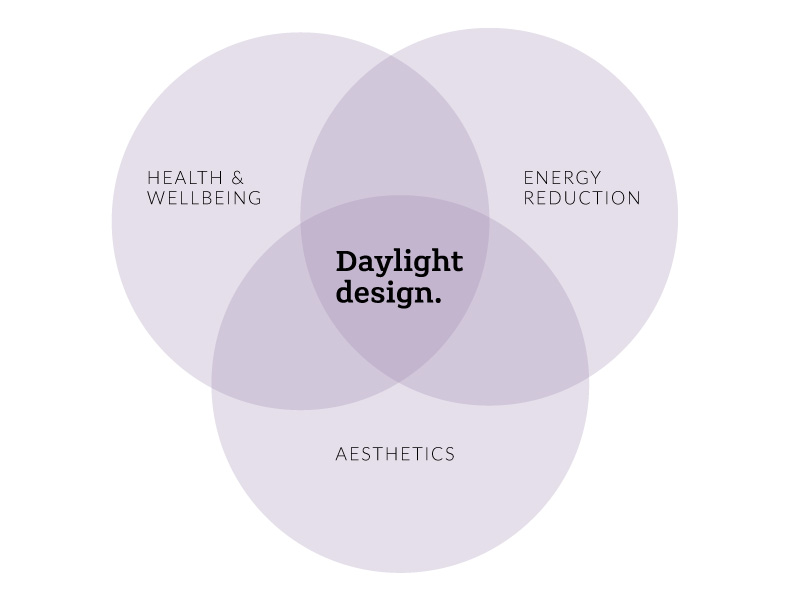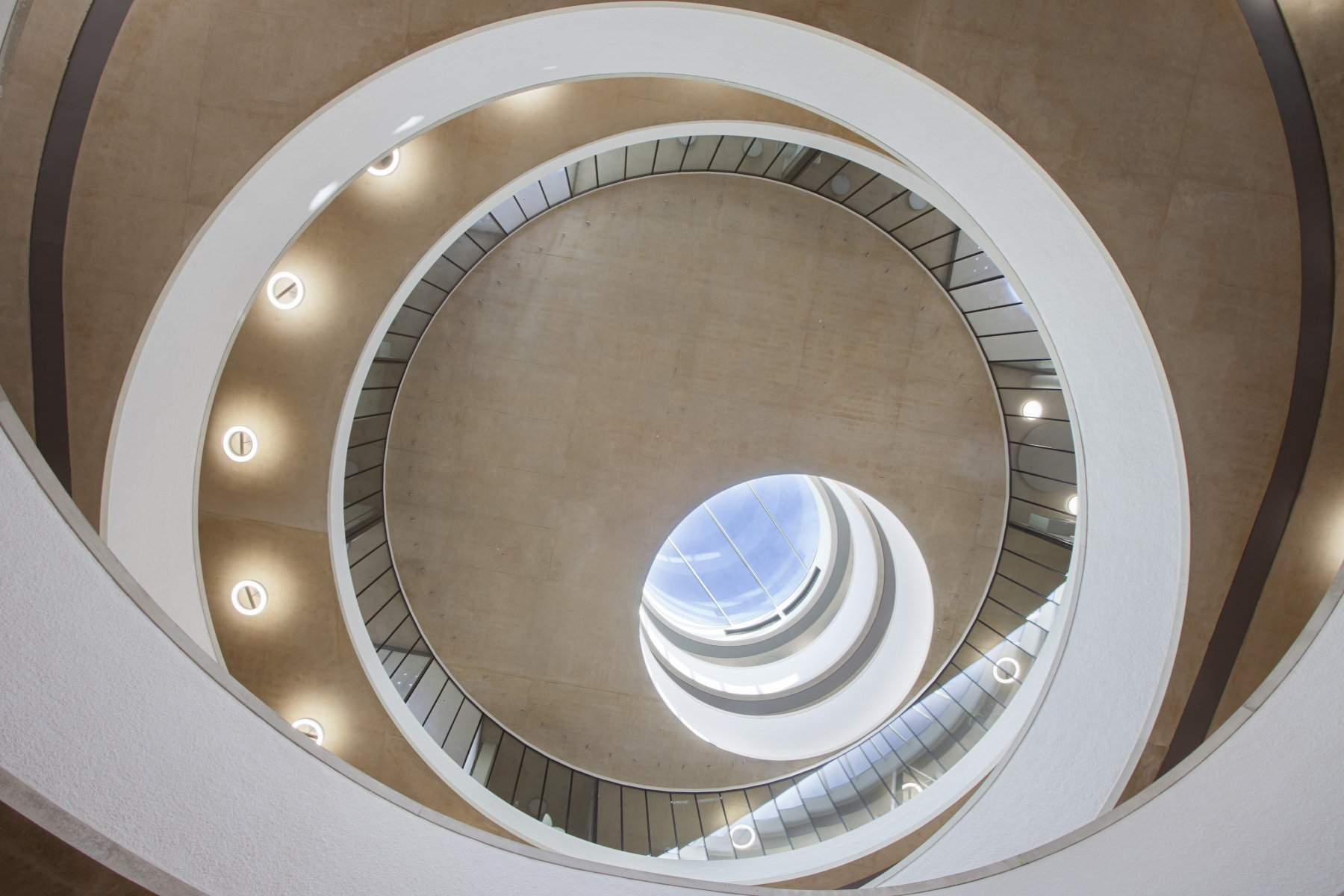Insights
The Power of Daylight Design.
Why does daylight matter in buildings?
There are a multitude of reasons for ensuring good daylight design in buildings. These can be grouped into what I like to think of as the ‘holy trinity’ of daylight: Health & wellbeing, energy reduction, and aesthetics.

Health and wellbeing.
As humans, we evolved in an outdoor world driven by the 24-hour light-dark cycle of the earth, and our biology is a testament to that. Our body clock, or circadian rhythms, has a natural cycle of slightly more than 24 hours, needs to be reset each day to ensure that we get tired at night and are alert during the day. Daylight exposure is the key to resetting our body clock each day, and studies have shown the particular importance of morning daylight exposure in this process. Added to this is the fact that inadequate daylight exposure, particularly in winter, is associated with mood disorders and other psychological impacts. Skin exposure to direct sunlight enables us to synthesise Vitamin D, a key nutrient for our health. There are several other health benefits associated with sunlight exposure (though we do need to limit excessive exposure in order to avoid skin cancers).
In our homes and hospitals, studies have shown that access to daylight helps our mental wellbeing, and can even accelerate the recovery process of patients. A view through a window connects us with the outside world, enabling us to place ourselves in time and space. We particularly benefit from views of nature or views containing nature elements, though a dramatic view of a city-scape from high up in a building will also do nicely!
Meanwhile, we also know that a comfortable workplace makes for a happier, more productive workforce… and the same applies in schools, colleges and universities.
Together, this mounting evidence is demonstrating the human importance – and benefits – of designing buildings that are primarily illuminated by daylight.
Energy reduction.
Daylight is a freely available natural resource. While there will always be a need for some form of artificial lighting strategy, if we consider daylight properly then the need for artificial lighting (and its associated energy requirements) can be substantially reduced, along with the benefits of solar gain when it comes to heating a space.
Aesthetics.
Human beings prefer daylit spaces. Good daylight design can render architectural features in a special way, enhancing and transforming a space. It is also synonymous with quality – that feeling we all crave for a “welcoming, light and airy space”. Daylight is the ultimate light source in terms of how it renders colours.
Can you have too much daylight?
Like any aspect of functional design, daylighting requires a delicate balance to ensure it works in the best possible way. Our wellbeing suffers at both ends of the scale; too much daylight can be just as harmful as not enough.
When it comes to buildings, our love affair with glass in architecture shows no sign of abating, and this copious glazing brings glare and overheating. This can then result in the oft-documented “blinds down, lights on” syndrome. This is bad for both energy consumption and occupants’ health and wellbeing.
Requirements for daylight.
One of the key characteristics of daylight is that it isn’t constant. Changing external illumination levels, cloud cover, and sunlight penetration are key factors in human response and appreciation, but also mean that quantifying daylight in buildings is not straightforward.
There are very few (or no) daylighting requirements or recommendations in existing standards and building regulations that are enforceable by law in any country. However, there are several daylight standards relating to different applications for which we are experienced in designing.
We believe daylight should be used as primary light source in buildings in daytime and fulfil both our visual and non-visual (biological) needs.
Daylight should be considered in building standards and regulations, tailored to the type of user in the building and the building type; and that any standards take into account the building’s energy performance, air quality and shading/facade type.
It’s important to note that a glazing ratio doesn’t automatically guarantee a certain amount of daylight inside a building. Influencing factors include: glass configuration, building overhangs, the outdoor environment (such as neighbouring buildings), and shading type. This means that having just a minimum ratio of glazing area cannot be considered as daylight legislation.
Is daylight important to my project?
It’s integral! Daylight is a free and natural source of illumination. Not only can it offset electrical lighting energy usage, it is essential for the health & wellbeing of building occupants.
Daylighting impacts a project’s success: affecting everything from planning, performance, selling, and the end-user experience.
A light source rich in vibrancy, colour, and energy, daylight is universally preferred due to its dynamic nature and the aesthetic benefits it brings to interiors. Well daylit buildings engender feelings of spaciousness and connection with the natural world, as well as being synonymous with quality.
What does a daylight designer do?
The best daylight specialists will:
- understand and consider the integration of daylighting with architectural lighting design
- set daylighting in the context of other competing demands such as thermal comfort, security, acoustics and, fundamentally, sustainability
- endeavour to meet the most rigorous building recommendations without compromising on energy use or the visual comfort of building users
- create detailed computer models using cutting-edge software
- use these tools to analyse and quantify daylight in an interior, and provide visualisations of the daylight movement and intensity through a space
Our daylight team.
Our daylight expertise is founded on our core belief that buildings need to work from a human perspective. This extends from, as a minimum, ensuring compliance with the appropriate standards, to helping achieve architectural solutions that are beautiful, functional, and truly sustainable.
When it comes to daylight design, we’ve built a portfolio to be proud of, acquiring creative dexterity and a deep understanding of what it takes to find the perfect balance of every project.



